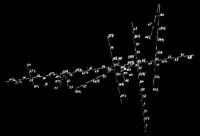
Return to Walden
works by Ken Steen
<sound> <home>
videos
these videos are playable on desktop, laptop, iPad, iPhone, iPod touch
and other cellular and mobile devices
appropriately optimized versions will load automatically
and they still may take a moment to download...
returning
sound & video: Ken Steen
duration: 30:00
I knew as soon as I arrived at Walden Pond that the most authentic way for me to engage with the pond and the surrounding woods was going to be through walking. Walking would both bring me to specific locations and would also provide for collection of materials during the process of walking and returning to various paths and locations: returning to Walden again and again in a process (or procession) of walking and resting - processing through the ambulatory-like paths of Walden Woods; motion through space balanced by contemplative observation and reflection.
The soundtrack is comprised of segments from a variety of harvested sources: ambient recordings at the site of Thoreau's original cabin, at the edge of a small pool of water not far from the pond, walking around Walden Pond and walking at Brister's Hill, land that is being preserved by the Walden Woods Project. Excerpts from these collected sounds were then processed using an application called MetaSynth which, among many other things, allows for photographs to be turned into sonic filters. The photos used for this purpose were taken from maps and surveys of Walden Pond, and other locations in the area, that were created by Thoreau. I also used some photos of Thoreau himself. This sonic filtering allowed me to utilize relevant manuscripts created long ago to sculpt the current sonic environment of Walden Pond.
The video images that comprise this piece are nearly all of the surface of Walden Pond. By spending time at and around Walden Pond my goal was to be enabled to dig beneath the surface of this iconic location and the literary figure of Henry David Thoreau; to get past the mythic, historical and commercial aspects of both the writer and the area, and to focus on what lies below the surface. A way into finding my own interior "walden" in the midst of the physical location of Walden itself.
The sound and video collection process became a kind of public performance: walking, returning to many of the same locations, encountering some of the same people from day to day, sitting and observing, walking, returning, simply recording what was happening in the park and at the pond at various times during the day.
Ultimately I find that returning is as much about memory as it is about a heightened awareness of self in relation to the natural environment: what is remembered, what is forgotten - what sound or image might encourage something to be remembered - or forgotten. Seeing and hearing the same things from different points in time, from different perspectives, through different filters - returning - in order to experience and respond - again. Seeing and hearing in new juxtapositions, in relation to new experiences, in relation to new and old histories, in relation to life lived and the passage of time.
doublewalk | dubbelelopen
[in collaboration with Anna van Stuivenberg]
sound, video & walking notes: in Passy: Anna van Stuivensberg / at Walden Pond: Ken Steen
editing and assemblage: Ken Steen
duration: 30:15
This is a sound, text and video collaboration between Anna van Stuivenberg and Ken Steen. The accompanying "walking notes" can be downloaded as a PDF <here>. It was undertaken as a way to connect the residency in Passy directly to Walden Pond where Ken was in residence, since he was unable to travel to France to participate in Passy.
Anna and Ken planned to take a walk at the same time on August 19, 2010: Anna in Passy from 18:00 - 18:30 and Ken at Walden Pond from 12:00 - 12:30. The guidelines that both artists attempted to follow were simply to videotape or document the entire walk in some way and to take brief notes about what each saw, heard or responded to about every 3 minutes or so. The resulting video is a juxtaposition of the two videotaped walks along with notes taken in Dutch (Anna) and English (Ken).
The video reveals interesting deviations that both artists took from the original guidelines in order to realize the goal: improvising with the pre-determined note-taking times, lingering a bit more or less etc. For example: Anna put her camera down while taking notes, so there are durations of visual stillness as the video marks the time she is writing notes. Ken, on the other hand, at approximately the predetermined observation times, videotaped the surrounding area and wrote notes later - intending that the video would fade to black and the notes would fill in that visual gap. In both cases, what is actually seen during stillness or emptiness needs to be filled in by the viewer based on the descriptions.
The two artists experienced a heightened awareness of both "self" and "other" in the performance and documentation of doublewalk. The awareness, that while each was on their own walk there was an "other" an ocean away that was doing the same thing at the same time, toward a common purpose, with similar awareness, was palpable. Though not explicitly planned nor sought after, this piece is a rather clear realization of the words of Thoreau:
"Could a greater miracle take place than for us to look through each other's eyes for an instant?"